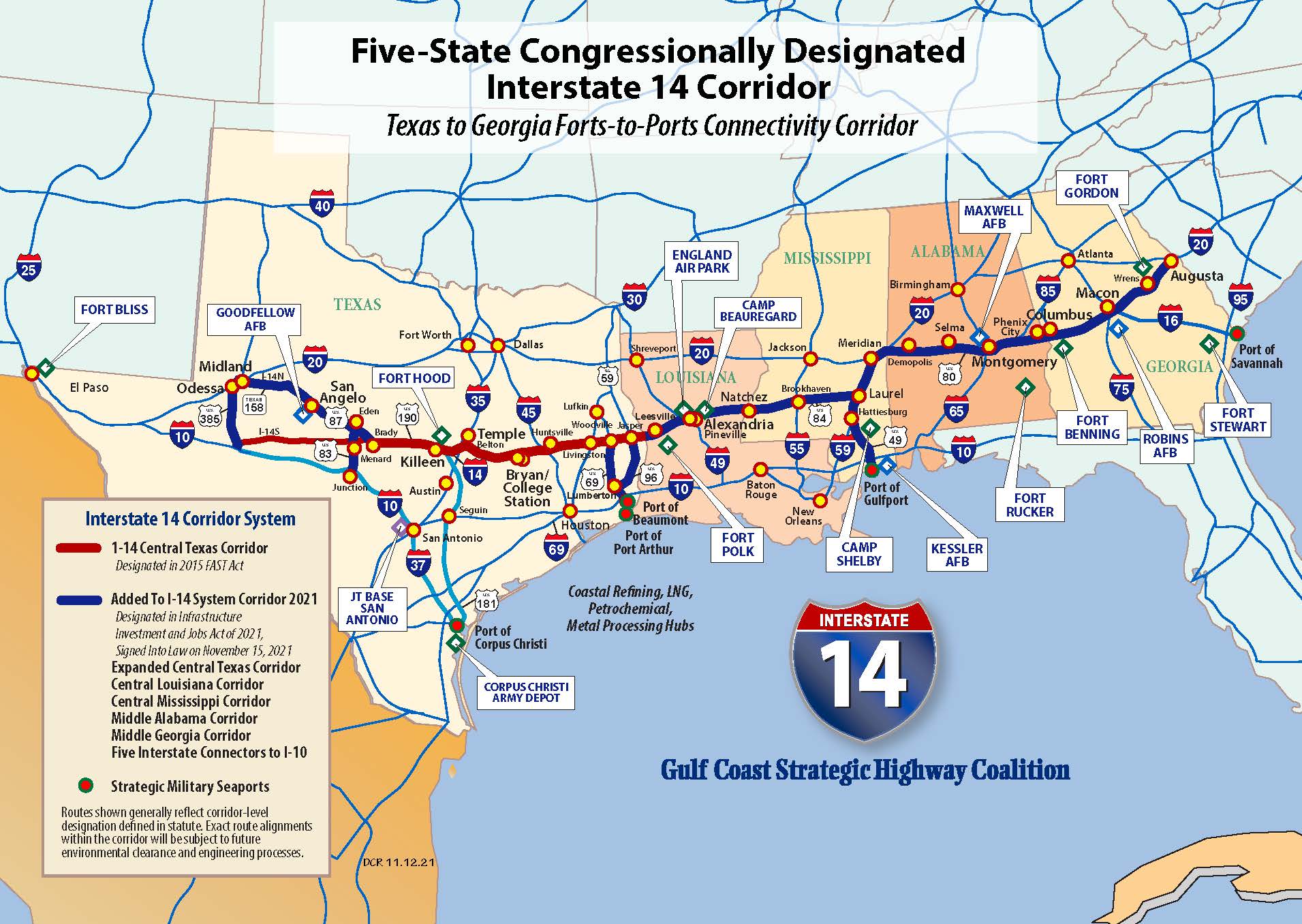Congressional designation of the Interstate 14 Corridor across Texas, Louisiana, Mississippi, Alabama, and Georgia became a reality Monday with the presidential signing of the $1.2 trillion bipartisan Infrastructure bill.
The newly designated I-14 route runs from Midland-Odessa across Central Texas to Alexandria, Louisiana, Laurel, Mississippi, Montgomery, Alabama, and Columbus, Georgia, before terminating at Augusta, Georgia. I-14 will be built primarily by incrementally upgrading existing highways in each of the states.
“We understand that building I-14 will require billions of dollars and many years to complete, but we are on our way,” said John Thompson, chairman of the I-14 Gulf Coast Strategic Highway Coalition, which has been building grassroots support for I-14 over the past decade.
“The I-14 system will improve connectivity between regions, provide freight movement efficiency, link important military facilities and strategic seaports, create a high elevation alternative for coastal sections of I-10 that are prone to flooding, and spur economic development opportunities along the 1,300-mile path,” he said.
Congress approved the first sections of the I-14 corridor in Texas in 2015, and a 25-mile section of freeway from Killeen/Fort Hood to I-35 in Central Texas became I-14 in 2017.
The new bill expands the Texas designation to include San Angelo and Midland Odessa. It also contains four north-south future interstate spurs that will connect I-14 to Interstate 10 and serve the Port of Corpus Christi, the Port of Houston, and the ports at Beaumont and Port Arthur. It also adds a north-south spur connecting to the Port of Gulfport, Mississippi. The designation includes a future interstate loop at Bryan-College Station designated Interstate 214.
Congressman Brian Babin of Woodville, Texas, has carried the I-14 legislation since entering Congress in 2015. It was successfully included in a House transportation bill passed earlier this year. It became the basis of an amendment to the bipartisan infrastructure bill offered in August by Senator Ted Cruz of Texas and Senator Raphael Warnock of Georgia. The I-14 designation had the support of all ten senators and every member of the House along the corridor.
Texas, Louisiana, Mississippi, Alabama, and Georgia state departments of transportation all provided Congress with letters supporting the new interstate corridor.
“We must now work to win funding for planning and construction of projects on the corridor, work that must be done with Congress, the U.S. Department of Transportation, and the departments of transportation in each of the states,” Thompson said.
A significant benefit of providing interstate linkage between a dozen military facilities served by the I-14 corridor is that these connections will add to the military value of each of these installations. Among the facilities that I-14 will better link are Fort Bliss at El Paso, Goodfellow AFB in San Angelo, Fort Hood at Killeen, Fort Polk in Louisiana, Camp Shelby at Hattiesburg, Kessler AFB at Biloxi, Maxwell AFB at Montgomery, Fort Benning at Columbus, Robins AFB at Macon, Fort Gordon near Augusta and Fort Stewart near Savannah.
In West Texas, the I-14 corridor follows SH 158 and U.S. 87 from Midland to San Angelo, and Brady then runs east on US 190 to tie into the existing section of I-14 at Killeen. The corridor runs east to Bryan/College Station and Huntsville before generally following US 190 through East Texas, crossing the Sabine River on LA 8 near Fort Polk at Leesville, Louisiana. In Louisiana, the corridor generally follows LA 28, connecting Leesville, Alexandria, and Vidalia. In Mississippi, the corridor starts at Natchez and runs east, following U.S. 84 to Laurel. It runs concurrently on I-59 to Meridian and generally follows U.S. 80 to Montgomery, Alabama, Columbus, Georgia, and Fort Benning. From there, it follows existing routes to Warner Robins, Macon, Fort Gordon, and Augusta. Spur routes connect to I-10 generally follow U.S. 83, U.S. 69, and U.S. 96 in Texas and I-59 and U.S. 49 in Mississippi.
###




